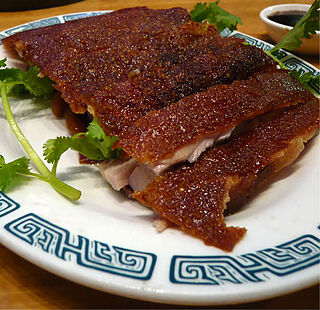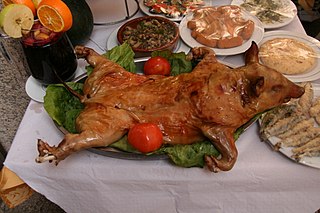
Asado are the techniques and the social event of having or attending a barbecue in various South American countries, where it is also a traditional event. An asado usually consists of beef, pork, chicken, chorizo, and morcilla which are cooked on a grill, called a parrilla, or an open fire. Generally the meats are accompanied by red wine and salads. This meat is prepared by a person who is the assigned asador or parrillero.

Churrasco is a Spanish and Portuguese term referring to beef or grilled meat more generally, differing across Latin America and Europe, but a prominent feature in the cuisine of Uruguay, Brazil, Bolivia, Argentina, Chile, Colombia, Nicaragua, Peru, Guatemala and other Latin American countries. The related term churrascaria is mostly understood to be a steakhouse.
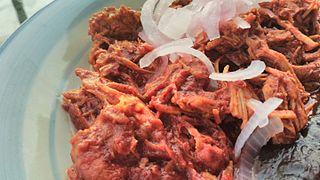
Cochinita pibil is a traditional Mexican slow-roasted pork dish from the Yucatán Peninsula. Preparation of traditional cochinita involves marinating the meat in strongly acidic citrus juice, seasoning it with annatto seed which imparts a vivid burnt orange color, and roasting the meat while it is wrapped in banana leaf.
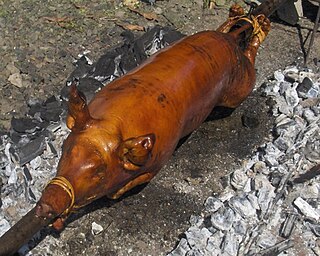
Lechón in Spanish is a pork dish in several regions of the world, most specifically in Spain and its former colonial possessions throughout the world. Lechón is a Spanish word referring to a roasted suckling pig. Lechón is a popular food in the Philippines, Cuba, Puerto Rico, the Dominican Republic, North Sulawesi province of Indonesia, other Spanish-speaking nations in Latin America, and Spain. The dish features a whole roasted pig cooked over charcoal. Additionally, it is popular in the Philippines with Cebu being acknowledged by American chef Anthony Bourdain as having the best pig. It is also the national dish of Puerto Rico.

Castilian-Leonese cuisine refers to the typical dishes and ingredients of the region of Castile and León in Spain. This cuisine is known for its cooked dishes ("guisos") and its grilled or roasted meats ("asados"), its high-quality wines, the variety of its desserts, its sausages ("embutidos"), and its cheeses. In addition, in certain areas of Castile and León, one can find the important production of apples, almond paste, etc.

A rib steak is a beef steak sliced from the rib primal of a beef animal, with rib bone attached. In the United States, the term rib eye steak is used for a rib steak with the bone removed; however in some areas, and outside the U.S., the terms are often used interchangeably. The rib eye or "ribeye" was originally, as the name implies, the center portion of the rib steak, without the bone.
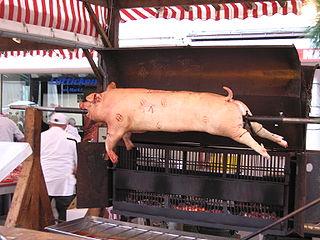
A pig roast or hog roast is an event or gathering which involves the barbecuing of a whole pig. Pig roasts in the mainland Deep South of the United States are often referred to as a pig pickin', although roasts are also a common occurrence in the Philippines, Puerto Rico and Cuba as well as the non-mainland US state of Hawaii, with roasts being done in the mainland states by descendants of other areas. A pig roast is traditional meal in Serbia and Montenegro, often prepared for celebration events and family fests, and it can be usually found on the menu of traditional taverns and bars - kafana.

Lechona and/or also known as lechon asado is a popular Colombian dish.

Lechazo is a Spanish dish made from "cordero lechal". The meat used is from unweaned lambs, and is similar to veal, or the meat of "cochinillo". The province of Castile and León has a distinctive version of lechazo referred to as "Lechazo de Castilla y Leon". It is one of the most important dishes of the cuisine of the province of Valladolid. Also, Aranda de Duero is known as the heart of the dish, with numerous restaurants that specialize in lechazo and feature "hornos de leña", or wooden stoves, in which the lamb is roasted.

Bavarian cuisine is a style of cooking from Bavaria, Germany.

Balinese cuisine is a cuisine tradition of Balinese people from the volcanic island of Bali. Using a variety of spices, blended with the fresh vegetables, meat and fish. Part of Indonesian cuisine, it demonstrates indigenous traditions, as well as influences from other Indonesian regional cuisine, Chinese and Indian. The island's inhabitants are predominantly Hindu and culinary traditions are somewhat distinct with the rest of Indonesia, with festivals and religious celebrations including many special foods prepared as the offerings for the deities, as well as other dishes consumed communally during the celebrations.

The gastronomy of the province of Valladolid comprises the meals, their preparation, and the culinary habits of the province of Valladolid. Of all the cuisines of the community of Castile and León, it is the most common. it is based on barbecued and roast food, especially roasted Spanish cuisine. Wines of high quality highlight the meals.

A suckling pig is a piglet fed on its mother's milk. In culinary contexts, a suckling pig is slaughtered between the ages of two and six weeks. It is traditionally cooked whole, often roasted, in various cuisines. It is usually prepared for special occasions and gatherings.




